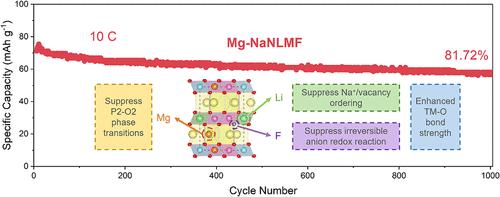p2型氧化物阴极的分层修饰策略实现了钠离子电池的高倍率性能和长期稳定性
IF 8.2
2区 材料科学
Q1 MATERIALS SCIENCE, MULTIDISCIPLINARY
引用次数: 0
摘要
P2-Na0.67Ni0.33Mn0.67O2阴极在钠离子电池(sib)中有着广泛的应用。然而,该材料面临着三个固有的关键挑战:4.2 V以上过度脱氧导致的不可逆P2-O2相变,特定钠浓度下不利的Na+/空位有序,以及高压运行时不可逆的阴离子氧化还原反应。本文设计了一种分层分层的修改策略来解决上述问题。在高电压下,氧位上的F取代显著增强了阴离子氧化还原反应的可逆性。Li掺入过渡金属位促进TM层内阳离子无序,有效抑制Na+/空位有序。同时,Li和F的存在增强了正负离子相互作用,增加了TM-O键强度,进一步增强了P2-NaNM材料的结构稳定性。在高压条件下,部分Mg取代钠位减轻了相邻氧层之间的排斥力,增强了相邻TM-O层之间的O-Na-O静电内聚力,从而阻碍了不可逆的P2-O2相变。结果表明,优化后的p2 - na0.67 ni0.25 li0.08 mn0.57 mg0.1 o1.93 f0.07 (Mg-NaNLMF)阴极具有优异的电化学性能,在0.1C条件下60次循环的容量保持率为98.07%。更令人印象深刻的是,在10C下1000次的超快充放电过程中,它保持了81.72%的初始容量。本工作为通过分层分层修饰策略设计高性能钠离子电池层状氧化物建立了新的范例。本文章由计算机程序翻译,如有差异,请以英文原文为准。

Layered Hierarchical Modification Strategy in P2-Type Oxide Cathodes Enables High-Rate Capability and Long-Term Stability for Sodium-Ion Batteries
P2–Na0.67Ni0.33Mn0.67O2 cathodes have been widely applied in sodium-ion batteries (SIBs). However, this material faces three inherent critical challenges: irreversible P2–O2 phase transitions caused by excessive desodiation above 4.2 V, unfavorable Na+/vacancy ordering at specific sodium concentrations, and irreversible anion redox reaction during high-voltage operation. In this work, a layered hierarchical modification strategy is well-designed to solve all the above problems. F substitution at oxygen sites significantly enhances the reversibility of anionic redox reactions at high voltages. Li incorporation into transition metal sites promotes cationic disorder within the TM layer, effectively inhibiting Na+/vacancy ordering. Meanwhile, the copresence of Li and F can strengthen cation–anion interactions and increase the TM–O bond strength, further enhancing the structural stability of the P2-NaNM material. The substitution of sodium sites by partial Mg mitigates repulsive forces between adjacent oxygen layers under high-voltage conditions, and enhances the O–Na–O electrostatic cohesion between adjacent TM-O layers, thereby impeding irreversible P2–O2 phase transitions. As a result, the optimized P2–Na0.67Ni0.25Li0.08Mn0.57Mg0.10O1.93F0.07 (Mg-NaNLMF) cathode exhibits exceptional electrochemical performance, delivering a capacity retention of 98.07% over 60 cycles at 0.1C. More impressively, it maintains 81.72% of the initial capacity after ultrafast charge/discharge processes of 1000 cycles at 10C. This work establishes a new paradigm for designing high-performance layered oxides in sodium-ion batteries through a layered hierarchical modification strategy.
求助全文
通过发布文献求助,成功后即可免费获取论文全文。
去求助
来源期刊

ACS Applied Materials & Interfaces
工程技术-材料科学:综合
CiteScore
16.00
自引率
6.30%
发文量
4978
审稿时长
1.8 months
期刊介绍:
ACS Applied Materials & Interfaces is a leading interdisciplinary journal that brings together chemists, engineers, physicists, and biologists to explore the development and utilization of newly-discovered materials and interfacial processes for specific applications. Our journal has experienced remarkable growth since its establishment in 2009, both in terms of the number of articles published and the impact of the research showcased. We are proud to foster a truly global community, with the majority of published articles originating from outside the United States, reflecting the rapid growth of applied research worldwide.
 求助内容:
求助内容: 应助结果提醒方式:
应助结果提醒方式:


